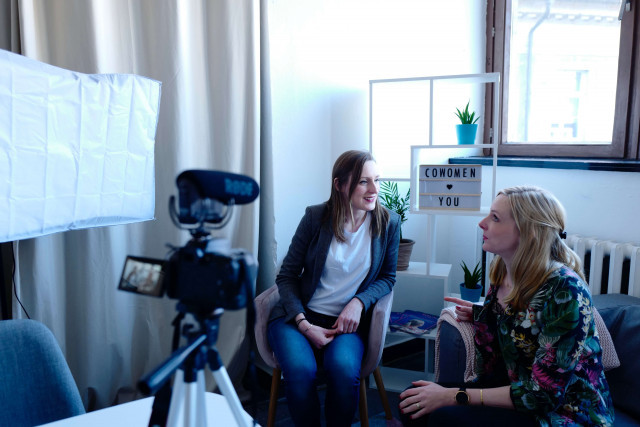I grew up in the world of local TV news. My mom worked at an ABC affiliate scheduling advertising, and I have vivid memories of my sister and me doing homework in the station’s break room next to the studio, the “on-air” light glowing red as I munched on Captain’s Wafer crackers or Bugles from the snack machine and the video crew put on another pot of coffee, knowing they’d be there until after the 11 o’clock broadcast. The evening weatherman George, a local celebrity, said hello to us in the hallway by name, and I imagined one day sitting in the anchor chair myself, reading the day’s headlines off the teleprompter.
Needless to say, my career path changed along the way for various reasons. I never ended up in front of the camera, but as a communications professional who now works daily in digital marketing, I or a member of my team are often behind a camera interviewing someone for a story.
Not every team has a dedicated videographer, and many times if you work in communications, you wear many hats. Here are eight tips I’ve picked up along the way that can help you when it comes to filming better interview videos. They will come in handy whether you are using a DSLR or a smartphone, which is often better when your end use is social and your video won’t need much editing.
1. Get close
Frame your subject so that their face fills the screen and there’s a little—but not too much—space above their head. This helps the viewer concentrate on what’s being said, and can even eliminate background noise when filming on a smartphone and all you have is that device’s mic.If the setting permits, try framing your subject using the rule of thirds, as it makes for the most interesting composition.
2. Consider the background
The goal is to have something interesting but not too interesting behind the subject. A busy street might make a good visual, but it also might be too noisy or distract from your subject. Imagine the video a lot like a still picture, the goal is to find a background that complements the entire frame without taking away from the main point, in this case your subject.
3. Make sure your subject is well lit
If you are shooting outside, after you find a suitable background (see above), you’ll need to angle your subject so that their face catches the natural light. You’ll know you need to move the subject if their face is too shadowy or dark. That can often happen if your subject is backlit, or the light source is behind them. If the background allows it, try turning around and shooting from the opposite side.
Tip: If you’re shooting outside on a sunny day, try finding a spot of shade to position your subject in. Direct sunlight can lead to hard lines on your subject’s face which isn’t always flattering. If you’re lucky and it’s an overcast sky, any angle will likely be great.
4. Use a tripod, if you can
Yes, it’s one extra piece of equipment, but it makes your video look much more professional (and keeps your audience from getting motion sickness from all the wobbling). Look for a tripod that has a wide range of height and metal legs. It should also have a level so you know you’re shooting a balanced video without a weird tilt.
5. Shoot with someone else
Sometimes, you have no choice but to go solo, but if you can bring a partner, it can make all the difference in a quick shoot or several takes. They can help control any distractions around your subject, such as people walking by or background noises. They also are helpful adjusting the shot if your subject moves during the interview.
6. Watch for glasses glare
When one of your subjects is wearing glasses, check for glare on the lens before shooting, which can be distracting for the viewer. You may need to angle them slightly to improve the glare. Check and double check before recording.
7. Ask your subject to stand, when possible
You won’t have to worry as much about posture if your subject stands, and they are likely going to be more at ease than if they were sitting, bracing for the next question. If your subject or the setting requires them to be seated, use a chair that doesn’t easily move or swivel so they don’t accidentally move out of the frame.
8. Remember to hold your smartphone the right way
Last but not least, make sure you film the right way if you are using a smartphone. The safest bet is to hold your phone horizontally, but if you know how you’re going to ultimately use the video (for example on YouTube versus Snapchat) then double check the guidelines of that channel first to make sure.
Learn more about earning a bachelor’s degree in communications or digital marketing and social media online from JWU. For more information, complete the Request Info form, call 855-JWU-1881, or email [email protected].
